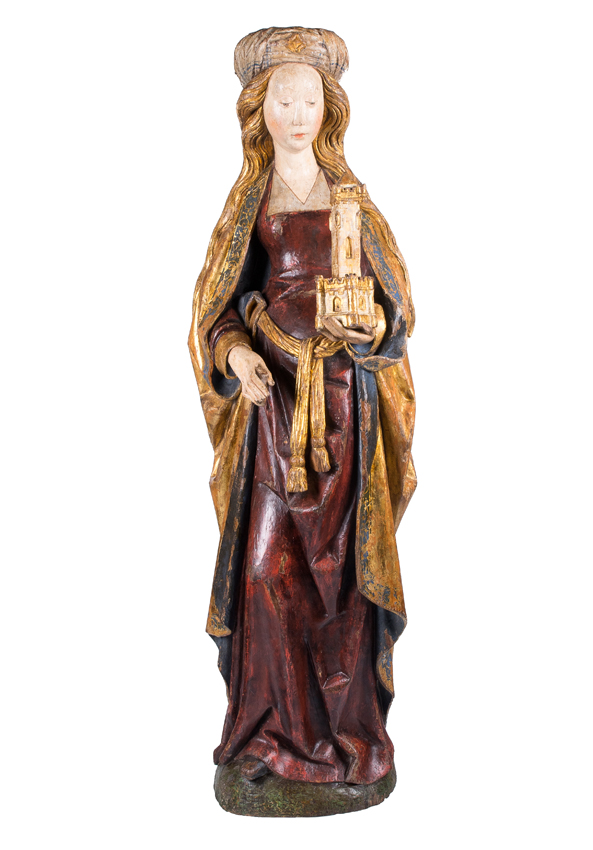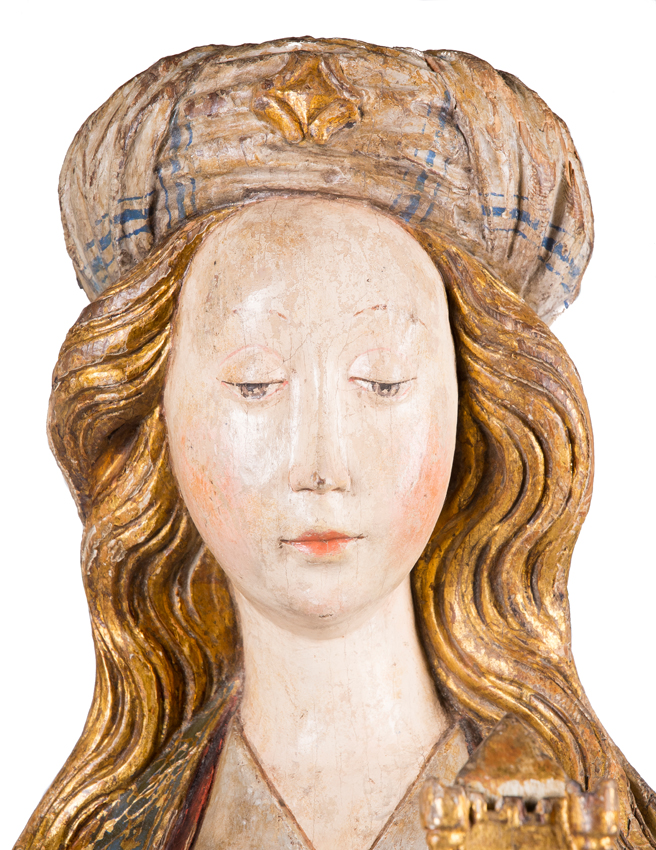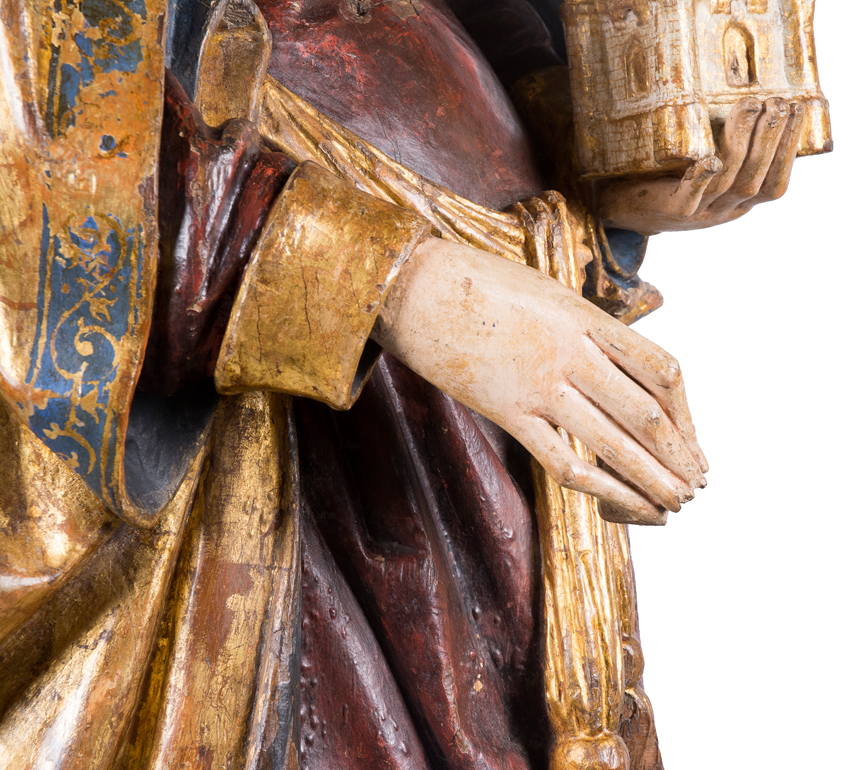11
Gil de Siloé (Antwerp, Belgium or Urliones, France?, circa 1467 - Burgos, 1505)
Gil de Siloé (Antwerp, Belgium or Urliones, France?, circa 1467 - Burgos, 1505)
"Saint Barbara"
Carved, gilded and polychromed wooden sculpture.
110 x 28 x 30 cm.
This image bears a great resemblance to the polychromed limestone sculpture of the Virgin and Child, from the facade of the arch of Santa María la Mayor, in Burgos, and which is currently on display at the Burgos Museum. The similarity to the face is remarkable, being an almond-shaped oval, with a long, thin nose and a small mouth with an expression so characteristic of the sculptor. To this can be added the treatment of the hair, made up of long, wavy locks, loose on both sides of her face.
The Saint is represented in a frontal position, standing with her right leg slightly forward, creating a contrapposto effect. Dressed in rich courtly clothing, she wears a dress in reddish tones tied with a fringed chord which falls to her feet forming folds reminiscent of Gothic folds. With a pronounced bosom, her white blouse peeks out and she is covered from shoulders to feet in a luxurious gold cloak with a blue interior. Saint Barbara gathers up the cloak with her right arm to pick it up, in one of the sculptor's graceful gestures.
This sculpture gives a strong indication of Gil de Siloé's origin being Flemish, evident in the headdress that covers part of the saint's head, in her extremely delicate hands and in the sweet beauty of the face.
Finally, the wonderful tower held in her left hand is remarkable and symbolizes Saint Barbara's attribute. In her other hand she would have held a palm, which is not preserved, symbolizing her martyrdom.
The tower, according to tradition, consists of three windows "to remember the words of the Saint, according to whom the light had entered her through the three windows of the Father, the Son and the Holy Spirit", as indicated by Don Luis Monreal y Tejada in his Iconography of Christianity. In this tower she was locked up by her father, Dioscuros, to protect her from her suitors. Saint Barbara, who had previously baptized herself, fled from the tower and was therefore arrested, tried and sentenced to death. The miracle occurred when, before being beheaded, lightning struck, killing her tormentors.
Saint Barbara, virgin and martyr, lived in Antioch in the middle of the 3rd century under the rule of Maximian.
Gil de Siloé was a sculptor who was the greatest representative of Elizabethan Gothic, a style typical of the Crown of Castile which originated after the merging of Mudejar art and Flamboyant Gothic with Flemish influences. His origin remains uncertain: it seems likely that he was Flemish and the fact that he sometimes signed "Gil de Enberres" (Amberes being the Spanish for Antwerp) attests to this, but he also sometimes signed "Gil de Urliones" (possibly referring to Orleans) so a possible French origin remains on the table.
Be that as it may, Burgos and his great artistic activity attracted him. He arrived there, as el Prado explains in its biography, with an already "defined sculptural language that he would maintain throughout his career and that is characterized by a detailed and meticulous technique that tends to cover all surfaces with decorative elements.” Despite having been called by the rich activity of Burgos, "he lived and worked in Burgos, in Castile, without his clients or the environment influencing him enough to make him change his art", affirms the professor of Art History from the University of Burgos, Dr. Alberto C. Ibáñez Pérez, in the article on Siloé from the Royal Academy of History.
The great quality and renown of his work resulted in the creation of a sculptural focus in Burgos, which "radiated its activity and influence throughout the Castilian territory" from the end of the 15th century.
Highlights of the artist's output include the altarpiece of the Tree of Jesse, the main altarpiece of the chapel of the Conception in Burgos Cathedral, made between 1483 and 1486, which is considered his first great work and was conceived "with the idea of uniting the three major arts in order to offer a message, in which reality presented with elegant detail served as visual support for the idea,” Ibáñez explains.
Also remarkable is the tomb of the parents of Queen Isabel the Catholic, documented in 1486, and that of her brother, Prince Alfonso, both works commissioned by the Queen and sculpted in alabaster, for the Miraflores Charterhouse. The church also has a a Madonna and Child by Siloé, known as the Virgin of the Choir, practically identical to the one exhibited in the Museo del Prado (E000961).
Reference bibliography:
- Monreal y Tejada, Luis. (2000). “Iconografía del Cristianismo”. El Acantilado.
- Ibáñez Pérez, Alberto C. (s.f.). “Gil Siloe”. Real Academia de la Historia. https://dbe.rah.es/biografias/14526/gil-siloe
- Museo del Prado. (s.f.). “Siloé, Gil de”. https://www.museodelprado.es/aprende/enciclopedia/voz/siloe-gil-de/fa1e7ddb-348a-4871-8f36-18363eb8e102
Gil de Siloé (Antwerp, Belgium or Urliones, France?, circa 1467 - Burgos, 1505)
"Saint Barbara"
Carved, gilded and polychromed wooden sculpture.
110 x 28 x 30 cm.
This image bears a great resemblance to the polychromed limestone sculpture of the Virgin and Child, from the facade of the arch of Santa María la Mayor, in Burgos, and which is currently on display at the Burgos Museum. The similarity to the face is remarkable, being an almond-shaped oval, with a long, thin nose and a small mouth with an expression so characteristic of the sculptor. To this can be added the treatment of the hair, made up of long, wavy locks, loose on both sides of her face.
The Saint is represented in a frontal position, standing with her right leg slightly forward, creating a contrapposto effect. Dressed in rich courtly clothing, she wears a dress in reddish tones tied with a fringed chord which falls to her feet forming folds reminiscent of Gothic folds. With a pronounced bosom, her white blouse peeks out and she is covered from shoulders to feet in a luxurious gold cloak with a blue interior. Saint Barbara gathers up the cloak with her right arm to pick it up, in one of the sculptor's graceful gestures.
This sculpture gives a strong indication of Gil de Siloé's origin being Flemish, evident in the headdress that covers part of the saint's head, in her extremely delicate hands and in the sweet beauty of the face.
Finally, the wonderful tower held in her left hand is remarkable and symbolizes Saint Barbara's attribute. In her other hand she would have held a palm, which is not preserved, symbolizing her martyrdom.
The tower, according to tradition, consists of three windows "to remember the words of the Saint, according to whom the light had entered her through the three windows of the Father, the Son and the Holy Spirit", as indicated by Don Luis Monreal y Tejada in his Iconography of Christianity. In this tower she was locked up by her father, Dioscuros, to protect her from her suitors. Saint Barbara, who had previously baptized herself, fled from the tower and was therefore arrested, tried and sentenced to death. The miracle occurred when, before being beheaded, lightning struck, killing her tormentors.
Saint Barbara, virgin and martyr, lived in Antioch in the middle of the 3rd century under the rule of Maximian.
Gil de Siloé was a sculptor who was the greatest representative of Elizabethan Gothic, a style typical of the Crown of Castile which originated after the merging of Mudejar art and Flamboyant Gothic with Flemish influences. His origin remains uncertain: it seems likely that he was Flemish and the fact that he sometimes signed "Gil de Enberres" (Amberes being the Spanish for Antwerp) attests to this, but he also sometimes signed "Gil de Urliones" (possibly referring to Orleans) so a possible French origin remains on the table.
Be that as it may, Burgos and his great artistic activity attracted him. He arrived there, as el Prado explains in its biography, with an already "defined sculptural language that he would maintain throughout his career and that is characterized by a detailed and meticulous technique that tends to cover all surfaces with decorative elements.” Despite having been called by the rich activity of Burgos, "he lived and worked in Burgos, in Castile, without his clients or the environment influencing him enough to make him change his art", affirms the professor of Art History from the University of Burgos, Dr. Alberto C. Ibáñez Pérez, in the article on Siloé from the Royal Academy of History.
The great quality and renown of his work resulted in the creation of a sculptural focus in Burgos, which "radiated its activity and influence throughout the Castilian territory" from the end of the 15th century.
Highlights of the artist's output include the altarpiece of the Tree of Jesse, the main altarpiece of the chapel of the Conception in Burgos Cathedral, made between 1483 and 1486, which is considered his first great work and was conceived "with the idea of uniting the three major arts in order to offer a message, in which reality presented with elegant detail served as visual support for the idea,” Ibáñez explains.
Also remarkable is the tomb of the parents of Queen Isabel the Catholic, documented in 1486, and that of her brother, Prince Alfonso, both works commissioned by the Queen and sculpted in alabaster, for the Miraflores Charterhouse. The church also has a a Madonna and Child by Siloé, known as the Virgin of the Choir, practically identical to the one exhibited in the Museo del Prado (E000961).
Reference bibliography:
- Monreal y Tejada, Luis. (2000). “Iconografía del Cristianismo”. El Acantilado.
- Ibáñez Pérez, Alberto C. (s.f.). “Gil Siloe”. Real Academia de la Historia. https://dbe.rah.es/biografias/14526/gil-siloe
- Museo del Prado. (s.f.). “Siloé, Gil de”. https://www.museodelprado.es/aprende/enciclopedia/voz/siloe-gil-de/fa1e7ddb-348a-4871-8f36-18363eb8e102
Apparitions, Miracles and Devotion
Sale Date(s)
Venue Address
General delivery information available from the auctioneer
The purchase price includes the delivery of the lots in the venue of the auction. Transporting to other destinations is at the own risk of the client. The customer must contact "LST", to give the corresponding instructions for such transporting. "LST" is not responsible for the packaging or any accident incurred during transportation.
Important Information
Apparitions and miracles inspired religious fervour; for centuries they fed the faith of believers and in the old continent they gave rise to marvellous works of art which became the most direct instruments for converting the New World to Christianity.
The power of image at its greatest splendour.
Terms & Conditions
CONDITIONS OF THE AUCTION:
I. REGISTRATION. To bid in the room customers must register at the beginning, filling out a form and picking a number that will identify them during the auction. Customers may be required to register in bank references or other guarantee system and if they do not prove the solvency "LST" will not accept bids and award the auction.
II. WRITTEN BIDS. "LST" will accept written bids, which will be formalized in the form provided by the room until the day before the auction. In such auctions, the room will bid in name of the client until the maximum stated in the offer and always at the lowest possible price. If there are two or more bids for the same amount, the one placed first will have the priority. Written bids received in advance, will have priority on the day of the auction.
III. TELEPHONE BIDS. "LST" will allow telephone bids, if interested people contact "LST" days before the auction providing personal data, ID card and the phone number which will be used by the staff of "LST" to call at the time of the auction. The buyer, within all the legal rights is making an offer for the asking price, when applies for telephone bid. "LST" will not take responsibility for any technical defects beyond its control, which may prevent to contact successfully the bidder during the auction.
IV. AUCTIONEER. The auction will be conducted by an auctioneer, director of the auction will be judge and arbitrator of it with full authority in its development, will award the lots to the highest bidder and is able to settle any controversy concerning lots sale, reject bids, divide lots or group them and remover objects from the room. Will be able to, if it is deemed suitable, not accept bids on the auction. His decision will be unappealable.
V. SALE OF LOTS. The lots are awarded to the highest bidder. Once the auctioneer blows the hammer, the buyer becomes responsible of the lot purchased, exempting "LST" of liability to for any damage and / or accidents that may occur. No refunds of lots.
VI. STARTING PRICE. The amount shown in the catalogue as the starting price for each lot will be, as a rule, the minimum selling price, except for exceptional cases where a reservation may be agreed upon with the seller or it set discretionary by the room.
VII. SCALE OF BIDS. The bids are set according to the following scale:
From 50.-€ to 200.-€…………………………………………..at 10.-€
From 200.-€ to 500.-€…………………………………… …25 in 25.-€
From 500.-€ to 1.000.-€………………………………..…..….50 in 50.-€
From 1.000.-€ to 2.000.-€………………………………..…100 in 100.-€
From 2.000.-€ to 5.000.-€……………………………….….250 in 250.-€
From 5.000.-€ to 10.000.-€…………………………………500 in 500.-€
From 10.000.-€ to 20.000.-€……………………………1.000 in 1.000.-€
From 20.000.-€ to 50.000.-€……………………………2.500 in 2.500.-€
From 50.000.-€ to 100.000.-€…………………………..5.000 in 5.000.-€
From 100.000.-€ to 100.000.-€………………………10.000 in 10.000.-€
From 200.000.-€ to 200.000.-€………………………25.000 in 25.000.-€
From 500.000.-€ to 500.000.-€………………………50.000 in 50.000.-€
VIII. RIGHT OF ADMISION. "LST" reserves the right to admission to the auction room and to reject, at its judgment, any purchase order, from clients whose solvency is not duly proved as well as not to sale auctions.
IX. SALE PRICES. The successful bidder of one or more lots must pay "LST" the final sale price achieves at auction, plus the 22 % plus 21% VAT on the commission, at total 26,62 % on Hammer Price.
X. CATALOG DATA. The catalogue data are obtained in order to careful research and advice, however, any responsibility is afforded about its accuracy. The lots will be auctioned in the state in which they are, not accepting any claims in restorations, breakage, damage, imperfections and, even description or numbering mistakes in the catalogue, in case of it, being the burden of the buyers to make sure before the auction that the description matches with their personal opinion about respective lot. The exhibition of the lots is intended to allow a perfect review and study of them.
XI. PAYMENT AND REMOVAL OF LOTS. Payment and removal of the lots will be held no later than five days following the auction. After this period expire without having the buyer removed the lot or lots purchases, it will accrue an expense of custody of 6 euros per day on each lot.
15 days after the auction without having the buyer paid and removes the sold lots, "LST" will inform the seller and there will begin judicial proceeding in order to obtain payment. The delay in payment by the purchaser of his/her sold lots will carry an interest increase at a rate of 1,5% per month.
XII. DELIVERY OF LOTS. The purchase price includes the delivery of the lots in the venue of the auction. Transporting to other destinations is at the own risk of the client. The customer must contact "LST", to give the corresponding instructions for such transporting. "LST" is not responsible for the packaging or any accident incurred during transportation.
XIII. RIGHT OF FIRT REFUSAL AND REPURCHASE. "LST" in order to article 38 of "Ley 16/1985 de 25 Junio del Patrimonio Histórico Español" (BOE. 155 June 29, 1985), will notify in advance to the Ministry of Culture, the content of their catalogues. Concerning the lots subject to the legislation referred to in the preceding paragraph, the Administration may exercise the rights of first refusal and repurchase according to the law. "LST" will watch over the protection of Artistic, Historical and Bibliographical Heritage of Spain. For customers out of European Community, a tax for export is required by the Administration.
XIV. VALUE ADDED TAX (I.V.A). This tax will be accrued on commissions of "LST" for buyers, using the rates prevailing on the date of the auction.
XV. DATA PROTECTION. In order to the "Ley 15/1999 de 13 de Diciembre, de Protección de Datos de Carácter Personal", the client authorize "LST", the inclusion of their data in a customer file, and for the promotion by "LST" of the objects at all times the rights of access, rectification or deletion of personal data by sending the appropriate request to the following address: LA SUITE SUBASTAS, C/ Conde Salvatierra, 8, 08006. Barcelona.
XVI. EXPRESS LEGAL JURISDICTION. These Conditions are governed by and interpreted in accordance with the rules of Spanish law. The mere act of participating in the auction as seller, buyer or bidder, implies acceptance of these Terms and Conditions.
Sales operations are understood to be held at the registered office of "LST", C/ Conde de Salvatierra, 8, 08006. Any dispute shall be taken to the competent courts of Barcelona, expressly waiving any other jurisdiction, in accordance with Article 55 of the "Ley de Enjuiciamiento Civil".




































